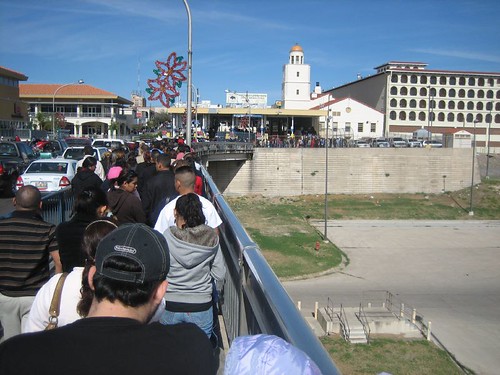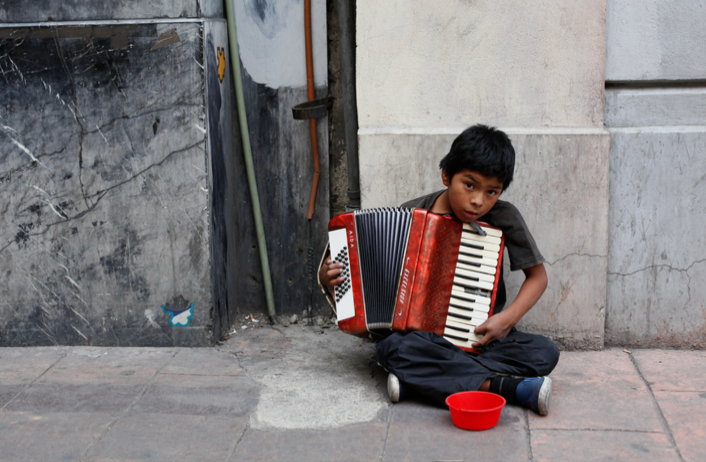Opinion: A Question of Responsibility
What is the crisis at the Mexican border, and what can US citizens do to help?
photo by Geraint Rowland, licensed under CC BY-NC 2.0
A young boy in the streets of Mexico City plays the accordion for spare change.
October 5, 2022
Families are sleeping in tents in a square formation in the northernmost part of Mexico awaiting entry into the US. Women and children are in the center of this jumble to attempt to keep themselves from the cartel’s grip, hiding in plain sight, risking their lives in hopes of a better future.
A decrease in economic assurance and an increase in organized crime rates have led to a surge in the number of Mexican citizens migrating to the US in the past two years.
Drug cartels play the largest role in Mexico’s economic and crime-related issues. The two largest cartels control the government through violence and power in numbers. Their control over the citizens of Mexico is built upon terror for their lives. The high poverty rates in Mexico also allow the cartel to gain more control through force.
In general, Mexican citizens are coming to the United States for a safer life.
The Cartel
Cartels are usually built upon families, so it is in their bloodlines to carry out their ancestors’ wishes. This is what makes it difficult to wipe out a cartel, because there are always distant relatives who can continue to carry out the work that is not yet done. Cartels smuggle cocaine, marijuana, methamphetamine, and heroin into the US every day.
There are two main drug cartel groups in Mexico: Sinaloa Cartel and Jalisco New Generation Cartel. Both of these groups have extensive influence across Mexico and internationally. With the money they gain from selling drugs, they pay off any government official in their way.
An anonymous Central American human trafficker gave gruesome details about what exactly the cartel does to innocent children–one of which is killing them and using their bodies to smuggle drugs. Another horrid action pursued by cartels is killing these children to sell their organs for money. All this is to instill a message of fear into the lives of Mexican citizens.
The Dangerous Trip to the United States
Clearing the two basketball-hoop-height fence at the border is the last and safest step in entering the US. To get to this point, immigrants ride on top of freight trains and face rape, kidnapping, and robbery on their journey.
The more money you have, the more likely you are to travel safely by bus or plane. However, the poverty rate is very high in Mexico. In 2020 the poverty rate in Mexico was 43.9%, while the US stood at an 11.4% poverty rate.
To avoid going through the heavily guarded areas, it is likely that Mexican citizens will travel through less densely populated parts of the United States. Deserts are a big risk, considering the high fluctuating temperatures between night and day, and the extremely rough terrain. These travel routes present a multitude of health risks that could turn fatal without proper care.

What exactly can US citizens do to help?
We must foster Mexican children. Many children come across the border unaccompanied, or their families cannot support them once they reach the United States. They need a stable and loving home while going through very difficult times in their lives.
There are different levels of the foster care system: short-term foster care (up to 29 days), long-term foster care (care until an adoptive home is found), and foster to adopt. Even taking on just a short-term foster child could make an important humanitarian impact.
Volunteers at the Mexican border are also needed for assistance in translating documents for Spanish and Haitian-Keyrol speaking individuals, as it is very easy for an immigrant’s intentions of entering to be misunderstood. Lawyers can also volunteer by representing asylum seekers pro bono.
No matter your politics, it is undeniable that the southern border is in need of assistance. Everyone has something that they can contribute to this ongoing issue.
_____________________________________________________________________________________
Editors’ note: All opinions expressed on The Uproar are a reflection solely of the beliefs of the bylined author and not the journalism program at NASH. We continue to welcome school-appropriate comments and guest articles.












